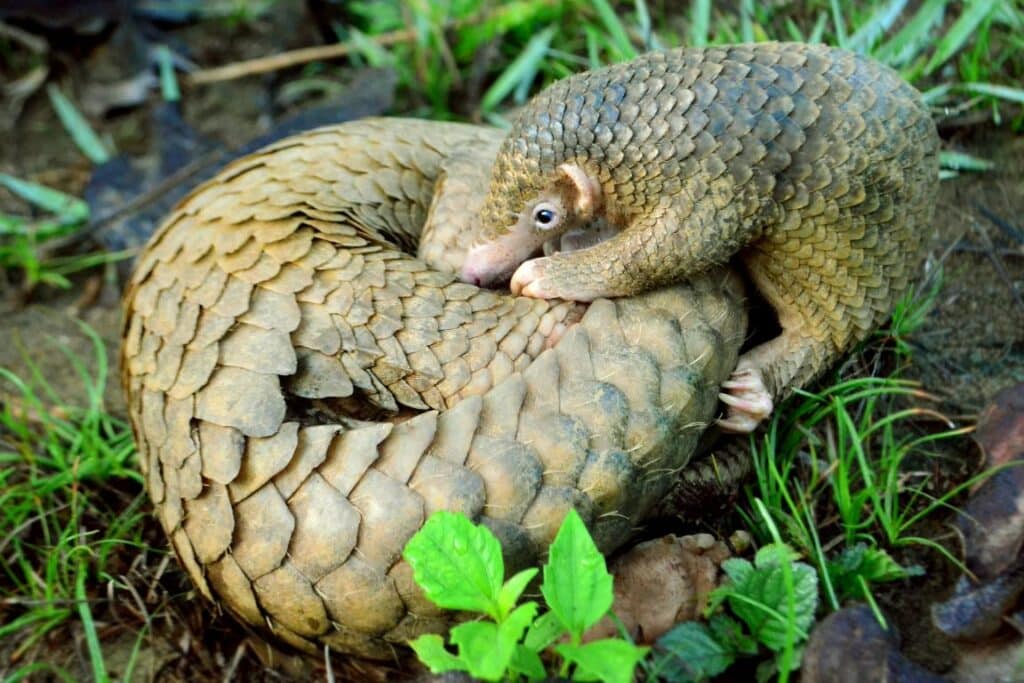Where the Internet installed a powerful circuit with highly conductive pathways for the sale and purchase of illegal wildlife, deep learning models show promise to insulate and inhibit the passage of trade. In March 2023, an international collaboration developed the first test case study using deep neural networks to identify species online, with the potential to interrupt pangolin trade from source to load.
—
It starts with images of pangolins. Eight different species across their native range: south of the Sahara, arboreal white or black-bellied pangolins climb and clasp on trees, while terrestrial giant ground pangolins scuttle across forest-savannah mosaics. Further east, Chinese pangolins furrow in underground burrows and emerge at night to feed and forage in bamboo and broadleaved forests. Indian pangolins on the rainforest canopy harvest ants attracted by fruit and flowers. Then there are images of pangolins rolled up in defence, protruding their scales to ward against predators many times their size. Or pangolins in crates and cages, alive or dead, obtained through seizures, or to be unloaded in wet markets. Pangolins are stripped of their pelts, and keratin scales are collected in jute bags. Each of these images is collated, sorted, annotated, and classified manually according to its content: “pangolins” or “no pangolins”, “pangolin entirely” or “pangolin parts”.
Using these images and textual classifications, Ana Sofia Cardoso – a researcher at the Research Centre in Biodiversity and Genetic Resources in Portugal – and her collaborators created a training dataset for deep learning models to identify pangolin species and flag illegal online trade instances.
When the world shut down for Covid19, pangolins became an emblem of the illegal wildlife trade. Uplisted from Appendix II to Appendix I of the Convention on International Trade in Endangered Species (CITES) in 2017, all commercial trade in the species is strictly prohibited. However, according to a recent report by the Global Initiative against Transnational Organized Crime (GI-TOC) – a multinational network where experts and civil society actors congregate to combat organised crime – pangolins are one of the most highly trafficked species and are increasingly sold in overlooked places: online markets.
Traders migrate from physical markets towards virtual platforms, which provide an accessible, cost-effective, and largely unregulated space. In this digital marketplace, high demand and low barriers to entry incentivise illicit and unsustainable harvest of the species.
Making use of the vast and highly conductive grid between billions of users on social media applications like Facebook, Twitter, WhatsApp, and Instagram and e-commerce platforms, sellers showcase pangolin products, connect to new buyers and rapidly change platforms when detected by enforcement agencies. The dark web integrates further layers of anonymity and untraceability on the board, encrypting the location and identity of users and keeping communications confidential.
To explore a potential tool both for scientific research and for law enforcement, the authors of the study used freely available deep learning models for two primary tasks – “classification”, which assigns a label or category to an input image, and “object detection”, which extends beyond simple identification but localises the object in its context– to make efficient the identification, monitoring and ultimately enforcement of traded species and its derivative parts from online content.
Like the way neurons and synapses signal and spark in the human brain, nodes and layers enable deep learning models to assimilate inputs and produce outputs. These artificial neural networks, where data is processed in manifold layers, are able to analyse texts, messages, and posts, identify content and classify images advertised online. What characterises deep learning is the ability to learn and improve from experience, automatically and without human intervention, identifying increasingly abstract representations of data from the new and the unseen.
The authors developed deep learning models with “feature visualization”, enabling the detection of not only wild, natural environments in which pangolins are located as well as their non-natural surroundings.
The neural networks showed high performance, both for classification and for object detection, being able to flag over 90% of potential instances of pangolin trade over the trained image set and accurately determine whole pangolins or derivative parts, as well as individuals in their habitats or in market settings.
There are, of course, some limitations. Sites on the dark web remain impervious from common search engines, and deep learning models will need to be further calibrated to improve their readings of low-resolution and poor-quality images. The true obstacle lies in the ignition: substantial human verification is needed of the initial data set, which requires considerable effort and may not be replicable at every species level. Nevertheless, the preliminary results show “the immense potential” of deep learning.
“We hope to contribute towards the development of a more efficient, low cost and less time-consuming tool,” the authors state.
The myriad of connectors in the digital wildlife trade network may well be better isolated and insulated in the face of an expanding field of digital conservation. However, as the world forays deeper into automated intelligence and learning, many critical questions arise in a conservation field already fraught with tensions: How will data collection and storage be governed, and what is the impact on the right to privacy? How will deep learning relate to and impact drivers, motivations, and other complexities behind the illegal wildlife trade?
Addressing how deep learning may serve or burden the wider socioeconomic and cultural system in which the illegal wildlife trade operates will be the first step towards shorting the circuit.
Featured image: Wikimedia Commons.
You might also like: 6 Facts About Pangolins: Diet, Threats, and Conservation

















